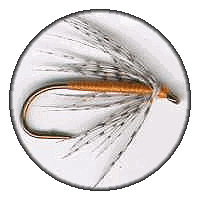|
Partridge and Orange Soft Hackle
Materials List:
Hooks: Wet fly.
Thread: Orange 6/0, or Pearsalls orange tying silk.
Body: Orange floss, or Pearsalls orange tying silk.
Hackle: Gray partridge, about 2 turns.
Tying Instructions:
1. "Mount" your thread on the hook, Syl Nemes starts it just back
from midshank.
2. Now tie in floss if you're using it, wrap forward
to just behind eye, tie in and trim excess. If just using thread,
wrap it forward, covering shank thoroughly. For large flies
using just thread, you may have to run the thread up and down
the hook a couple times to get the body built up.
3. Select your hackle, in general, the hackle should
be sized so the barbs extend about to the back of the bend,
so the barbs would be slightly longer than the shank. Stroke the
hackle fibers backward, so they stand out at right angles to
the stem. Hold it by the tip to do this. Strip off the fluff from
the base of the stem on both sides.
4. Tie in the hackle just back from the eye, so the
"natural curve of the feather is towards
the hook" or so the concave side faces you.
5. Do NOT advance thread to in front of feather.
Make 1 1/2 to 2 wraps with the partridge hackle, then leave
the hackle pliers hanging down below the hook, still holding
the butt of the feather. Make sure you keep the convex side
of the feather facing forward as you wrap. At this point, the
thread is behind the wrapped hackle now bring the thread
forward thru the hackle, being sure to wrap down the stem
once as you go. Be careful not to bind down
any fibers. Now advance thread to the eye, trim excess butt
of feather.
6. Form a neat, tapered head. Whip finish and cut thread.
7. Cement.
Fishing the Fly:
This is the way Syl Nemes ties them. I love these flies,
and am to the point where I fish them at least 50% of the
time. The traditional method of fishing them is "greased line".
Basically, casting across stream, holding the rod toward
your bank, and moving the rod out toward the fly and
feeding slack to slow the drift. The idea is to get a mostly drag free
drift, while keeping the line tight enough that you feel the strikes.
I fish these in the traditional method, as well as many others.
They work well fished like a nymph, dry or emerger as well.
Give them a try, you WILL catch fish.
If you want to learn more about the fishing technique,
tying, or history of these flies, there are three books
available entirely on soft hackles. The author, Syl Nemes,
has written a trilogy: THE SOFT HACKLED FLY,
THE SOFT HACKLED FLY ADDICT , and SOFT
HACKLED FLY IMITATIONS. All three are great reading,
I would recommend them to everyone. ~ Matt
Be sure to read Al Campbell's Product Review on Mustad Hooks in
Product Review!
Stay tuned - Bob Jacklin will soon begin a Weekly Tying Tip section here!
~ LadyFisher
|



